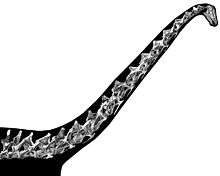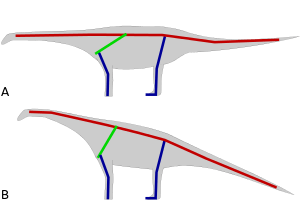Sauropod neck posture

Sauropod neck posture is a subject occasionally debated among scientists, who consider either a horizontal, or upright posture to be how the necks were held habitually.[1]
Biomechanics
The biomechanics of sauropod skeletons and necks can help determine at what angle the neck was positioned.[2]
Flexibility
In 2013, a study led by Matthew J. Cobley and published in PLOS ONE focused on the flexibility of the necks of sauropods. They compared the necks of ostriches with sauropod genera to find out how flexible the necks really were. The study noted that previous biomechanics studies found the necks to have been positioned between the extremes of a vertical, and a downward slanted neck. In conclusion, the study found that sauropod neck flexibility should not be based on osteology alone, and if it is, the results should be used with caution. Even though there is a lack of preserved muscle tissue that would determine flexibility, sauropod necks were probably less flexible than previously thought.[3]
In 2014, Mike P. Taylor analysed the flexibility in the necks of Apatosaurus and Diplodocus. He found that Cobley et al. was incorrect in the fact that vertebrae imply the neck is less flexible than in actuality. Cobley et al. found necks to be much less flexible than in reality when cartilage was added. It was found that the cartilage between the joints would have allowed for the neck to flex far past 90°. However, Taylor noted that the neck, while it could flex above the vertical, the osteological neutral pose would have been around horizontal, and the habitual pose would have held the head upwards in an alert pose.[4]
Muscling
Sauropod necks were probably highly muscled to suit their feeding level. Brachiosaurus brancai (now Giraffititan) was probably a high browser, so it would have been more muscled along the neck than other sauropods like Diplodocus and Dicraeosaurus who were low browsers. The tail and limb length of B. brancai would also need to greater, to balance out the inclined neck.[5] However, the question of whether sauropods were endothermic of ectothermic plays a major part in how sauropods were muscled, as endotherms have particularly more intestines and stomach than ectotherms. The amount of gut needed could determine how much food was eaten by sauropods, and therefore at what elevation there heads were held.[6]
Heart and metabolic stress
The previous upright posture of sauropod necks would require great blood pressure and a strong heart. One 2000 study conducted by Roger Seymour and Harvey Lillywhite found that the blood pressure needed to reach the head with an upright neck would be 700 millimetres of mercury (28 inHg). This could be fatal to an endotherm, and also highly dangerous to an ectotherm. If sauropods were endothermic metabolically, it would certainly be impossible for them to survive with upright necks, as the blood pressure would be to high to live even with thicker heart muscling.[7] A later study by Seymour concluded that it would have required half the energy of any particular sauropod to pump the blood to the head. This would lower the probability of sauropods being high browsers, and instead having lower necks while feeding than commonly portrayed.[8]
Hypotheses
A few hypotheses have been generated to solve the dispute over how sauropods held their necks.[1]
Horizontal pose
Kent Stevens and Michael Parrish are the two main supporters of a horizontal neck posture. In 1999, they studied the genera Apatosaurus and Diplodocus, finding the habitual pose of the genera to be slightly declined. They claimed that both sauropods had necks much less flexible than previously thought, with the neck vertebrae of Diplodocus being more inflexible than Apatosaurus. Those two poses would suggest that the sauropods were ground feeders, instead of browsing off taller flora.[11] Later, in 2005, Stevens and Parrish again studied the biomechanics of sauropod necks, but this time on a wider variety of sauropods, those inhabiting the Jurassic. Specifically, Apatosaurus, Diplodocus, Camarasaurus, Brachiosaurus, Dicraeosaurus, Cetiosaurus, and Euhelopus were studied, and each and every one was stated to have a horizontally held neck by Stevens and Parrish. The pair even went as far a saying that all but a few had necks that curved downward towards the head.[12] However, in 2009 multiple things were found to be incorrect with this hypothesis. Michael P. Taylor et al. compared the neck posture of sauropods to that of extant reptiles, finding the habitual pose of different sauropods to be quite different from the hypothesis of Stevens and Parrish, including an upright neck for Diplodocus. The inaccuracies of Stevens and Parrish come mostly from their thought about the habitual pose, which was, according to them, the Osteological Neutral Pose (or ONP) of every sauropod. Taylor et al. find the ONP not to be the habitual pose, far from it, but just the midpoint between the two structural extremes of the neck orientation.[1]
Incline pose
Another, more widely supported hypothesis about sauropod neck posture is that the necks were held at an incline, but not as upright as commonly shown.[1] Daniela Schwartz et al. in 2006 published a study of the scapula and coracoids, sometimes fused into scapulocoracoids, of sauropod genera. Previously, sauropod shoulder girdles were thought to have been positioned horizontally along the torso, but Schwartz et al. found that the girdles should not have been positioned horizontally, and instead, they would have been angled at an average of 55° to 65°. The study reconstructed the skeletons of Diplodocus, Camarasaurus, and the titanosaur Opisthocoelicaudia, all known from a complete shoulder girdle, with the correct orientation of the scapulocoracoids. For Diplodocus, a 60° shoulder blade would have meant that the neck was more-or-less horizontal,[10] not too much different from the horizontal pose.[11][12] A juvenile Camarasaurus found by Gilmore was originally described as having the scapulocoracoid in "just the right place", but with it oriented at an angle of 45°, Schwartz et al. criticized the stance. The skeleton found by Schwartz et al. with the angle of the scapulocoracoid is similar to previous reconstruction of the genus by Osborn and Mook, and Jensen. Opisthocoelicaudia was found to have had two possibly poses, both with the scapulocoracoid angled at about 60°. No previous reconstructions, unlike with Camarasaurus, have restored Opisthocoelicaudia similarly.[10]
Upright pose for some sauropods
Euhelopus and Brachiosaurus have been found to be among only a few sauropods to hold their necks at a vertical angle, which would have been impossible for other sauropods. Many studies have stated that the blood pressure and energy spent would have been too great to survive, but for Euhelopus and Brachiosaurus it would have suited them better. The energy spent by pumping blood to the head would probably be too great for sauropods, but when they travel often, which has been suggested for those two genera, it would have actually saved energy. The biomechanical evidence favours an upright neck when travelling to spread apart resources. The study finding this conclusion also tested how much energy would have been expended when walking 100 m (330 ft) and standing, both with an upright neck. The approximate conclusion was that an about equal amount of energy would have been used up. Elongated cervical ribs are skeletal evidence for a strong core to support the neck and limit its movement when walking. The study supports the idea that during times of drought and famine, an upright neck was crucial for these sauropods to survive.[2]
References
- 1 2 3 4 Taylor, M. P.; Wedel, M. J.; Naish, D. (2009). "Head and neck posture in sauropod dinosaurs inferred from extant animals". Acta Palaeontologica Polonica. 54 (2): 213–220. doi:10.4202/app.2009.0007.
- 1 2 Christian, A. (2010). "Some sauropods raised their necks–evidence for high browsing in Euhelopus zdanskyi". Biology Letters. Royal Society. 6 (6): 823–825. doi:10.1098/rsbl.2010.0359. PMC 3001369
 . PMID 20519198.
. PMID 20519198. - ↑ Cobley, M. J.; Rayfield, E. J.; Barrett, P. M. (2013). "Inter-Vertebral Flexibility of the Ostrich Neck: Implications for Estimating Sauropod Neck Flexibility". PLoS ONE. 8 (8): e72187. doi:10.1371/journal.pone.0072187.
- ↑ Taylor, M.P. (2014). "Quantifying the effect of intervertebral cartilage on the neutral posture in the necks of sauropod dinosaurs". PeerJ. 2: e712. doi:10.7717/peerj.712.
- ↑ Christian, Andreas (2008). "Neck posture and overall body design in sauropods". Fossil Record. Wiley. 5 (1): 271–281. doi:10.1002/mmng.20020050116.
- ↑ Franz, R.; Hummel, J.; Keinzle, E.; Kölle, P.; Gunga, H-C.; Clauss, M. (2009). "Allometry of visceral organs in living amniotes and its implications for sauropod dinosaurs". Proceedings of the Royal Society B: Biological Sciences. Royal Society. 276 (1662): 1731–1736. doi:10.1098/rspb.2008.1735. PMC 2660986
 .
. - ↑ Seymour, R. S.; Lillywhite, H. B. (2000). "Hearts, neck posture and metabolic intensity of sauropod dinosaurs". Proceedings of the Royal Society B: Biological Sciences. 267 (1455): 1883–7. doi:10.1098/rspb.2000.1225. PMC 1690760
 . PMID 11052540.
. PMID 11052540. - ↑ Seymour, R. S. (2009). "Raising the sauropod neck: It costs more to get less". Biology Letters. 5 (3): 317–9. doi:10.1098/rsbl.2009.0096. PMC 2679936
 . PMID 19364714.
. PMID 19364714. - ↑ Borsuk-Białynicka, M.M. (1977). "A new camarasaurid sauropod Opisthocoelicaudia skarzynskii gen. n., sp. n. from the Upper Cretaceous of Mongolia" (PDF). Palaeontologia Polonica. 37: 5–64.
- 1 2 3 Schwarz, Daniela; Frey, Eberhard; Meyer, Christian A. (2007). "Novel reconstruction of the orientation of the pectoral girdle in sauropods". The Anatomical Record. 290: 32–47. doi:10.1002/ar.20405.
- 1 2 Stevens, K. A. (1999). "Neck Posture and Feeding Habits of Two Jurassic Sauropod Dinosaurs". Science. 284 (5415): 798–800. doi:10.1126/science.284.5415.798. PMID 10221910.
- 1 2 Stevens, K.A.; Parrish, M.J. (2005). "Neck Posture, Dentition, and Feeding Strategies in Jurassic Sauropod Dinosaurs". In Tidwell, Virginia; Carpenter, Kenneth. Thunder-lizards: The Sauropodomorph Dinosaurs. Bloomington: Indiana University Press. pp. 212–232. ISBN 0-253-34542-1.
